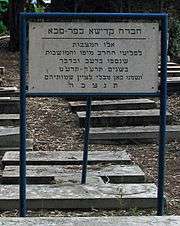Tel Aviv and Jaffa deportation


The Tel Aviv and Jaffa deportation refers to the forcible deportation of the entire civilian population of Jaffa and Tel Aviv on April 6, 1917, by the Ottoman authorities in Palestine. While the Muslim evacuees were allowed to return before long, the Jewish evacuees were not allowed to return until after the British conquest of Palestine.[1]
Background
In November 1914, the Ottoman Empire entered World War I on the side of the Central Powers. Many people from the opposing Allied countries lived in Palestine at this time, and Turkish officials there considered them a threat to military security. This group included recent Jewish arrivals from Russia.
In December 1914, the Turks expelled the 6,000 Russian Jews who resided in Jaffa.[2] They were resettled in Alexandria, Egypt.[3]
By January 1917, British forces had crossed the Sinai Desert and were about to invade Palestine, alarming the Turkish authorities.
Deportation
Ahmed Jamal Pasha, the military governor of Ottoman Syria, ordered the deportation.
The Jews of Jaffa and Tel Aviv organized a migration committee headed by Meir Dizengoff and Rabbi Menachem Itzhak Kelioner. The committee arranged the transportation of the Jewish deportees to safety with the assistance of Jews from the Galilee, who arrived in Tel Aviv with carts. The exiles were driven to Jerusalem, to cities in central Palestine (such as Petah Tikva and Kfar Saba) and to the north of Palestine, where they were scattered among the different Jewish settlements in the Lower Galilee, in Zichron Yaacov, Tiberias, and Safed. Around 10,000 deportees were evacuated from Tel Aviv, which was left with almost no residents.
The homes and property of the Jews of Jaffa and Tel Aviv were kept in the possession of the Ottoman authorities and they were guarded by a handful of Jewish guards. Jamal Pasha also released two Jewish doctors to join the deportees. Nonetheless, many deportees perished during the harsh winter of 1917–1918 from hunger and contagious diseases. 224 deportees are buried in Kfar Saba, 15 in Haifa, 321 in Tiberias, 104 in Safed, and 75 in Damascus.[4] In total some 1,500 are believed to have died, many victims buried without a name.[5] Only after the conquest of the northern part of Palestine by the British forces at the end of 1918 were the deportees allowed to return to their homes.
References
- ↑ Friedman, Isaiah (1971). German Intervention on Behalf of the "Yishuv", 1917 , Jewish Social Studies, Vol. 33, pp. 23–43.
- ↑ Mary McCune (July 2005). The Whole Wide World, Without Limits: International relief, gender politics, and American Jewish women, 1893-1930. Wayne State University Press. p. 46. ISBN 978-0-8143-3229-0. Retrieved November 26, 2010.
- ↑ Jonathan R. Adelman (2008). The Rise of Israel: A history of a revolutionary state. Routledge. pp. 58–59. ISBN 978-0-415-77510-6. Retrieved November 26, 2010.
- ↑ Nadav Shragai (September 12, 2007). מדוע לא מנציחה עיריית תל אביב את נספי גירוש 1917? [Why doesn't the municipality commemorate the deportation victims of 1917?]. Haaretz (in Hebrew). Retrieved August 14, 2014.
- ↑ in the homepage of Tel Aviv's founding families Archived September 19, 2008, at the Wayback Machine.
External links
- Tom Segev (October 5, 2009). "When Tel Aviv was a wilderness". Haaretz. Retrieved August 14, 2014.
- Tel Aviv and Jaffa deportation on the Tel Aviv municipality website (Hebrew)